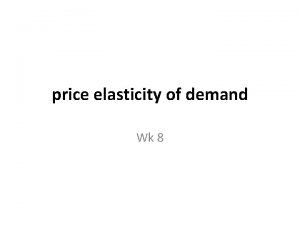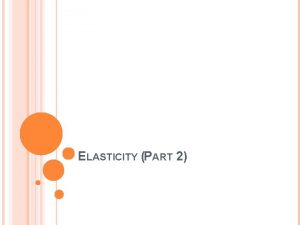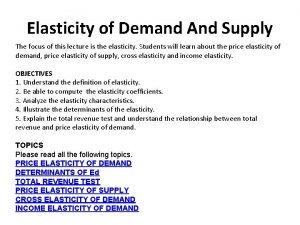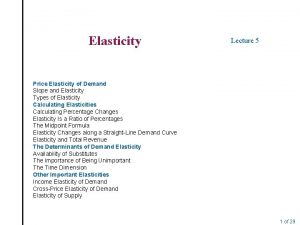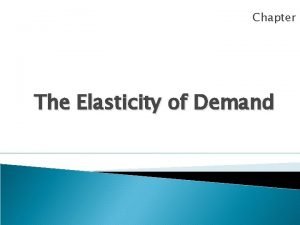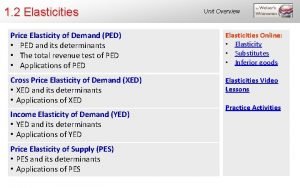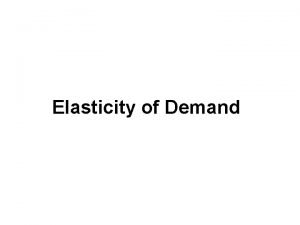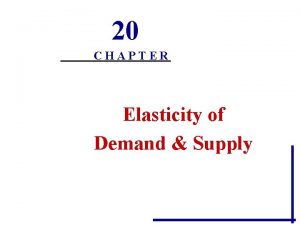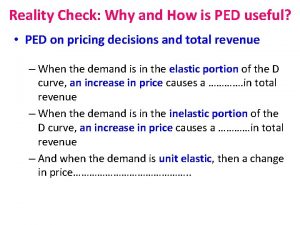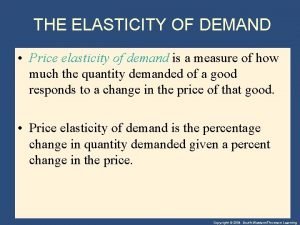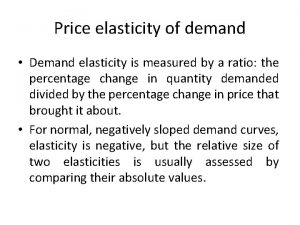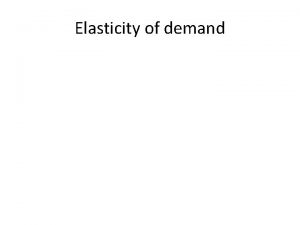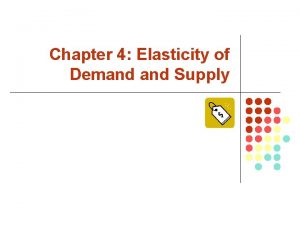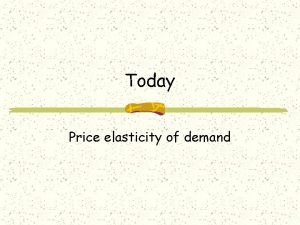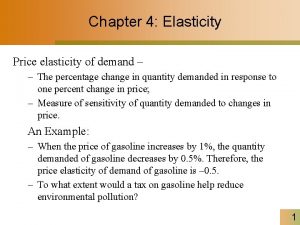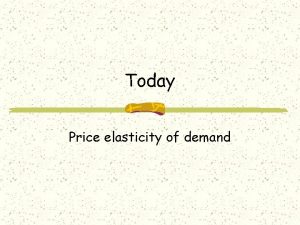Chapter 18 Elasticity Price Elasticity of Demand Elasticity
















- Slides: 16

Chapter 18 Elasticity

Price Elasticity of Demand • Elasticity measures the responsiveness (sensitivity) of consumers to a change in price • Formula: E = %ΔQ / %ΔP • Absolute Value – eliminate the negative sign

Elastic Demand • E>1 • A small change in price leads to a large change in quantity demanded • Example – Restaurant Meals

Inelastic Demand • E<1 • A change in price has little effect on quantity demanded • Examples – electricity, milk, gas, cigarettes

Special Situations • E = 1 : unit elasticity • Perfectly Elastic Demand – An increase in price results in sales of 0 – Horizontal demand curve Perfectly Inelastic Demand - A change in price has no influence on quantity demanded. - Vertical demand curve - Examples – Insulin, Heroin

• Elasticity varies over various parts of the demand curve. • Demand is more elastic in the upper left portion of the demand curve. • Graph • Note - Slope does not measure elasticity.

Total Revenue Test • TR = P×Q • If demand is elastic, a decrease in price will increase TR. • If demand is inelastic, a decrease in price will decrease TR. • If demand is unit elastic, a decrease in price will not change TR • Graph

Determinants of Elasticity • Substitutability: more substitutes = greater elasticity of demand – Lowering trade barriers increases substitutes, increasing elasticity – Elasticity varies depending on how narrowly a product is defined. • The demand for Honda’s is more elastic than the demand for automobiles

Determinants (cont. ) • Proportion of Income: The demand for low priced items tends to be inelastic • Luxuries vs. Necessities: The demand for most necessities is inelastic • Time : Elasticity increases over time – people develop tastes for substitutes

Elasticity of Supply • If producers are responsive to price changes, then supply is elastic. If they are unresponsive to price changes, then supply is inelastic. • E = %ΔQs / %ΔP • E>1 : supply is elastic • E<1: supply is inelastic • E will not be negative (law of supply)

Time – The Main Determinant of Supply • Market Period – producers are unable to change output, supply is perfectly inelastic • Short Run – plant size is fixed, but the firm is able to use its plant more or less intensively • Long Run – All resources are variable, firms may enter or exit the market

Cross Elasticity of Demand • Cross Elasticity measures the effect of a change in price of one good on the quantity demanded of a different good • E = %ΔQ of y / %ΔP of x • Substitute Goods – Cross Elasticity is positive • Complementary Goods – Cross Elasticity is negative • Independent Goods – Cross Elasticity is 0 or near 0

Income Elasticity • E = %ΔQ / %Δ in income • Normal Goods – Income Elasticity is positive • Inferior Goods – Income Elasticity is negative

Consumer Surplus • The difference between what a consumer (or consumers) is willing to pay for a unit of a product or service and its market price. • Graph

Producer Surplus • The difference between market price and the price at which a producer (or producers) is willing to sell a unit of a good or service. • Graph

Efficiency Loss • Also called Deadweight loss • When a good is either over produced or under produced there is a loss of consumer and producer surplus. • Graph
 Cross-price elasticity of demand formula
Cross-price elasticity of demand formula Formula for elasticity of demand
Formula for elasticity of demand The income elasticity of demand
The income elasticity of demand What are the 5 determinants of price elasticity of demand
What are the 5 determinants of price elasticity of demand Total expenditure method
Total expenditure method What are the 5 determinants of price elasticity of demand
What are the 5 determinants of price elasticity of demand Perfectly elastic demand
Perfectly elastic demand Price elasticity of demand formula
Price elasticity of demand formula Midpoint formula economics
Midpoint formula economics Unitary elastic demand
Unitary elastic demand Types of price elasticity of demand
Types of price elasticity of demand Xed economics formula
Xed economics formula Objectives of elasticity of demand
Objectives of elasticity of demand Calculate the price elasticity of demand
Calculate the price elasticity of demand A perfectly inelastic demand schedule
A perfectly inelastic demand schedule Price elasticity of demand
Price elasticity of demand Cross price elasticity
Cross price elasticity
